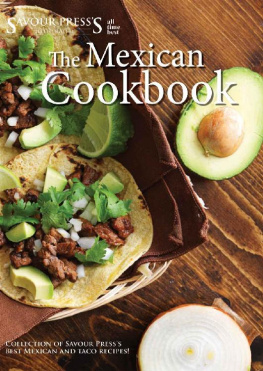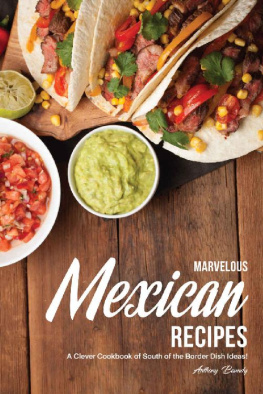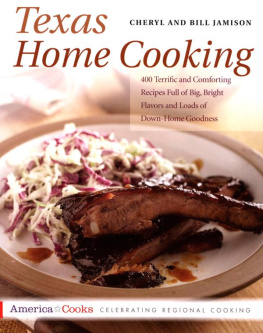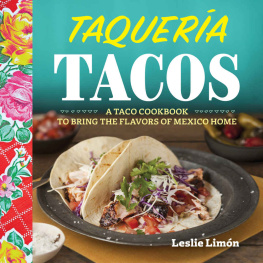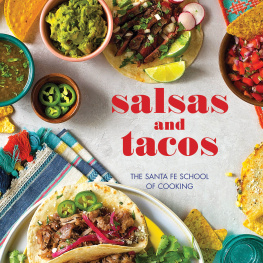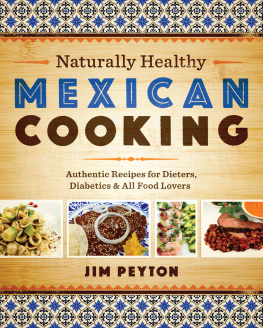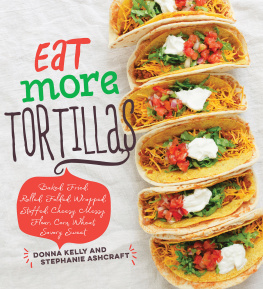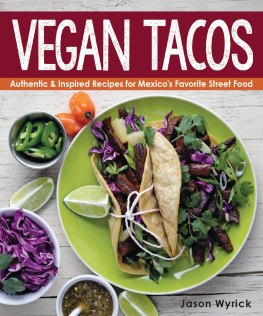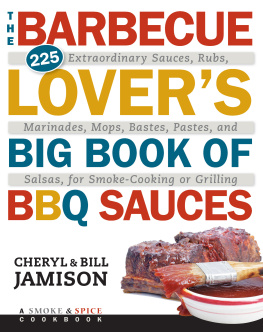Cheryl Alters Jamison - The Border Cookbook: Authentic Home Cooking of the American Southwest and Northern Mexico
Here you can read online Cheryl Alters Jamison - The Border Cookbook: Authentic Home Cooking of the American Southwest and Northern Mexico full text of the book (entire story) in english for free. Download pdf and epub, get meaning, cover and reviews about this ebook. year: 1995, genre: Home and family. Description of the work, (preface) as well as reviews are available. Best literature library LitArk.com created for fans of good reading and offers a wide selection of genres:
Romance novel
Science fiction
Adventure
Detective
Science
History
Home and family
Prose
Art
Politics
Computer
Non-fiction
Religion
Business
Children
Humor
Choose a favorite category and find really read worthwhile books. Enjoy immersion in the world of imagination, feel the emotions of the characters or learn something new for yourself, make an fascinating discovery.
- Book:The Border Cookbook: Authentic Home Cooking of the American Southwest and Northern Mexico
- Author:
- Genre:
- Year:1995
- Rating:4 / 5
- Favourites:Add to favourites
- Your mark:
- 80
- 1
- 2
- 3
- 4
- 5
The Border Cookbook: Authentic Home Cooking of the American Southwest and Northern Mexico: summary, description and annotation
We offer to read an annotation, description, summary or preface (depends on what the author of the book "The Border Cookbook: Authentic Home Cooking of the American Southwest and Northern Mexico" wrote himself). If you haven't found the necessary information about the book — write in the comments, we will try to find it.
Cheryl Alters Jamison: author's other books
Who wrote The Border Cookbook: Authentic Home Cooking of the American Southwest and Northern Mexico? Find out the surname, the name of the author of the book and a list of all author's works by series.
The Border Cookbook: Authentic Home Cooking of the American Southwest and Northern Mexico — read online for free the complete book (whole text) full work
Below is the text of the book, divided by pages. System saving the place of the last page read, allows you to conveniently read the book "The Border Cookbook: Authentic Home Cooking of the American Southwest and Northern Mexico" online for free, without having to search again every time where you left off. Put a bookmark, and you can go to the page where you finished reading at any time.
Font size:
Interval:
Bookmark:
THE HARVARD COMMON PRESS
535 Albany Street
Boston, Massachusetts 02118
Copyright 1995 by Cheryl Alters Jamison and Bill Jamison
Illustrations 1995 by Sara Love
All rights reserved. No part of this publication may be reproduced or
transmitted in any form or by any means, electronic or mechanical,
including photocopying, recording, or any information storage or
retrieval system, without permission in writing from the publisher.
Printed in the United States of America
Library of Congress Cataloging-in-Publication Data
Jamison, Cheryl Alters.
The border cookbook : authentic home cooking of the American
Southwest and Northern Mexico / by Cheryl Alters Jamison and
Bill Jamison,
p. cm.
Includes index.
ISBN 1-55832-102-0 (cl.)ISBN 1-55832-103-9 (pbk.)
I. Cookery, American-Southwestern style. 2. Cookery, Mexican.
I. Jamison, Bill. II. Title.
TX715.2.S69J35 1995
641.5979dc20
95-10799
Special bulk-order discounts are available on this and other Harvard
Common Press books. Companies and organizations may purchase
books for premiums or for resale, or may arrange a custom edition, by
contacting the Marketing Director at the address above.
Cover and text illustrations by Sara Love
Cover and text design by Joyce C. Weston
Map by Charles Bahne
10 9 8
For Lenore Tapia and family
The history of the U.S.-Mexican border area makes it one of the world's great culinary regions, similar to the great feeding grounds of the oceans, where currents of different temperatures meet. Just as this mixture produces waters teeming with all kinds of creatures, so the migrations of different peoples to the border area have created a region of rich cultural exchange, between Indians and Spanish, vaqueros and cowboys, and Hispanics and Anglos.
The Border Cookbook is the finest collection of recipes from this great culinary area of the Americas. In reading this book, I have relived my own taste experiences over and over again: the lobster and fish tacos in the fishing villages of Baja, the nopales, the albndigas, the soups of corn and shrimp with their fiery broths, the enchiladas with shredded dried beef, the huitlacoche, the blue crab soups, and the stuffed squash blossomsall of the dishes I have come to know and love.
The homey, gutsy foods of the border are full of big flavors, flavors that feed the soul and the spirit. These are the dishes that have sustained the peoples of the Southwestfrom the early natives to the tourists who come from the city on weekends to see the "real America." Here, where sunsets are a hundred miles wide, where you can ride for days and never see anyone, where the coyotes howl and the stars are overwhelmingly beautiful, the foods have to be big in spirit. This amphitheater of nature is no place for timidity; the people are strong and honest, and the food here reflects the spirit of both the land and its people. These dishes need no fancy names or pretty presentations. They do not have to be served on fancy china or at "in" restaurants to be appealing. Wherever they're found, these foods refuse to be overlooked. "Here I am,"they say. "This is what I stand for. Take me or leave me."
I remember my first experience eating Mexican food as a child. One Sunday morning I returned from church to smell a new aroma in the house, wafting from the kitchen. It wasn't something familiar, like my grandmother's French Canadian breakfasts of baked beans with molasses, eggs, and homemade breads with country honey and butter. It wasn't my godmother's spicy pasta sauce with Italian sausage. The aroma was much stronger, hanging in the room like a string of Christmas lights. In the kitchen I found my mother cooking juicy red sausage. Slowly sizzling in the skillet, it was loose and rich. This was the source of the intriguing smell. Impulsively, I took a bit on a fork and blew on it to cool it down. When I put it in my mouth, there was an explosion of flavors, and then a quiet blast of heat. This was my first encounter with chorizo. That morning I had my first of many breakfasts of scrambled eggs, chorizo, corn tortillas, and hot chocolate. I was hooked. My experience of food had become enlarged, and this experience enlarged my world.
Like many Americans who grew up on the East Coast, I was unaware of the rich history and cuisine of the West, a land that was settled by Europeans well before the Mayflower landed. I was unaware of Thanksgiving celebrations by the early explorers of the Southwest, five generations before the Pilgrims' first feast. I knew only the America east of the Mississippi.
Over the past thirty-five years I have traveled widely, studying, cooking, and eating the foods of "the Border." They represent some of my fondest eating memories, some of the tastiest down-home good times. Their excellence is no longer a secret, of course. Three hundred and fifty years after whites began settling the East, the foods of the West have come to symbolize America. Salsa has overtaken ketchup as the top-selling condiment, and tacos can be found from Paris to Sydney. The foods that originated in the border area have become icons of American cuisine.
These foods can be found in so many places today, in fact, that often they have lost some of their original character and flavor, or they have become misunderstood. Cheryl and Bill Jamison's book puts all of these foods back into their settinginto the context of their history, their geography, and their people. Reading The Border Cookbook, I was impressed at how Cheryl and Bill have captured the feel and flavor of this land and its people. Each page taught me something new about the history of border foodwhere cheese was first made in Mexico by the Mennonites, what plants the Spanish nurtured in the mission gardens in Arizona and Sonora, and the surprising tale of why there are Chinese influences in Baja cuisine. The Jamisons trace the development of each recipe, sometimes all the way from its pre-Columbian origins to its modern adaptations.
This book is not just historical, though. It is about a living culture and cuisinea culture that is constantly in transition, a cuisine that is always modifying its flavors. Border food reflects not only how people have lived, but how they live now. In lovingly presented sketches, Cheryl and Bill describe today's heroes of the cuisine. People like Jo Ann Casados, who makes New Mexican food the same way it has been prepared in her family for generations. People like Norman Fierros, a Phoenix chef who creates new incarnations of old dishes while keeping the spirit of the original intact. These peoplehome cooks, famous chefs, teachers, sheepherders, artists, and tortilla makersdefine their cuisine as it defines them. The food and the people are one and the same.
Most books on Southwestern and Mexican cooking make the political border separating the United States and Mexico the boundary of their subject matter. In treating the region and its culinary heritage as a whole, the Jamisons show that the way people eat, more than their political allegiance, defines who they are. This book shows how the dishes of the border unite the people of Mexico and the southwestern United States in one kitchen.
Just as people of the border area have learned and borrowed from one another to enjoy life more, the Jamisons, with true Southwestern hospitality, share their knowledge of how to add these culinary pleasures to your life and how to share them with your family and friends. Cheryl and Bill exhibit an encyclopedic knowledge not only of the region's history, people, and culinary traditions, but also of culinary methods and the botany of food plants. As a professional chef, and as one who has spent a long time learning about these great traditions, I am glad to see the wealth of information on cooking techniques, equipment, and ingredients, especially Southwestern foods such as chiles. (If this book had been written twenty years ago, my life would have been a lot simpler!) The recipes, carefully collected from the best sources, are for quiet home-cooked meals as well as for celebrations and special events. The list of sources in the back of the book alone makes it worth having.
Next pageFont size:
Interval:
Bookmark:
Similar books «The Border Cookbook: Authentic Home Cooking of the American Southwest and Northern Mexico»
Look at similar books to The Border Cookbook: Authentic Home Cooking of the American Southwest and Northern Mexico. We have selected literature similar in name and meaning in the hope of providing readers with more options to find new, interesting, not yet read works.
Discussion, reviews of the book The Border Cookbook: Authentic Home Cooking of the American Southwest and Northern Mexico and just readers' own opinions. Leave your comments, write what you think about the work, its meaning or the main characters. Specify what exactly you liked and what you didn't like, and why you think so.






